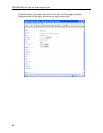
5320/5330/5340 IP Phone SIP User and Administrator Guide
29
Shared Lines and Keys
There are three types of shared lines:
• SIP: basic shared line with limited features (supports call forking but does not have LED
activity and lines are not linked. This type of shared line is available in normal SIP mode).
• SIP_BLA line type: server-enhanced Sylantro Bridged Line Appearance line type
• SIP_SCA line type: server-enhanced Broadworks Shared Call Appearance line type
BLA and SCA line types allow calls and lines to be shared by multiple users. A SIP server
provides support for call presentation to multiple phones, call state notifications, and access
control. SIP mode shared lines are shared among users but, normally, only the user who initiates
activity on the line has full control over it. For example, if a shared line is in use (not on Hold), and
secondary share users press their corresponding line button, the shared line will not change
state. If the shared line is Ringing, or on Hold, any share user who presses the corresponding line
button will change the state of that call and get connected to the calling/held party. An exception
to this scenario occurs when the server is configured to allow line seizure by multiple lines. Mitel
SIP phones support multi-call server programming.
Requirements for making calls and picking up held calls from shared lines are the same as for
normal (non-shared) lines.
Shared Lines and Keys Programming Requirements
Before programming the Shared Lines and Keys, the Broadsoft server must be configured with a
list of shared users.
The diagram below shows an example of how Mitel Users 1 – 3 have been configured on the
Broadsoft server to communicate with 3 Mitel phones. The three lines used on these phones are
shared lines; if a call is directed to User 1 then all three phones are alerted. If User 3 answers the
call then Line 1 on Phone 1 and Line 2 on Phone 2 indicate an active line.


















